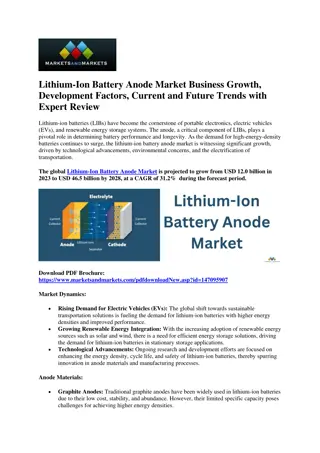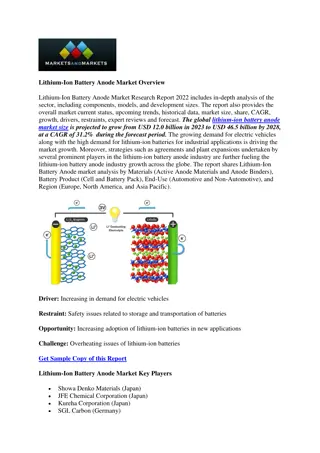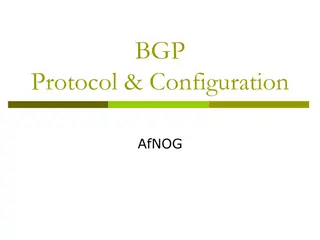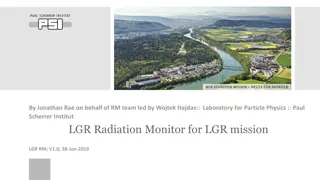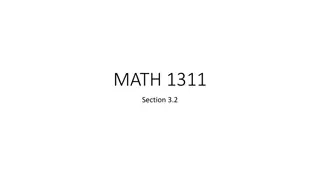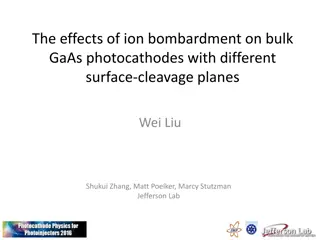Understanding Shuttling and Filtering of Multiple Ion Species in Segmented Linear Trap
This content delves into the intricate processes of shuttling and filtering multiple ion species within a segmented linear trap. It explores techniques such as RF filtering, DC potentials, mass filtering, and trap depths in the context of ion manipulation. Discussions also touch on ion crystal phase transitions, dynamics, and effects on melting or chaotic dissociation. Various schemes and methods are presented to optimize ion trapping and filtering for research and practical applications.
Uploaded on Sep 17, 2024 | 0 Views
Download Presentation

Please find below an Image/Link to download the presentation.
The content on the website is provided AS IS for your information and personal use only. It may not be sold, licensed, or shared on other websites without obtaining consent from the author. Download presentation by click this link. If you encounter any issues during the download, it is possible that the publisher has removed the file from their server.
E N D
Presentation Transcript
Shuttling and filtering multiple ion species in segmented linear trap
Mg+and He+ion shuttling Video file by T. W. H nsch courtesy T. Udem 2014.09.22
Segmented trap Electron gun for He ionization Helical resonator: Q = Simulated axial potential for different DC voltages on neighboring electrodes Electrode assembly with tank circuit sketch Figures from J. Robin Master s thesis [1] 2014.09.22
Possible Schemes RF Filtering Shuffling with DC potentials Mass filter Dual frequency Combination of techniques 2014.09.22
Well depth of linear quadrupole trap with 2 grounded electrodes Mathieu parameters: ???? ? 2?02 ??= ??= 2???? ? 2?02 ??= ??= Secular frequency, from solution to Mathieu equation for stable region ? ,?2 1: ?2 2+ ? ??= 2 Harmonic pseudopotential approximation: ?,? =? 2??2?2+ ?2 ?2???2 16? 2?02 Energy depth at rods for ? = 0, ? ?? ? = ?0: ? = 2014.09.22
RF Filtering (1 of 3) Lighter ions experience a deeper well, but also have higher q value: ???+ ???+= ?( 4??+ 24??+)= 6 Pseudopotential With filtering region ? for He+ for Mg+ Scheme framework: 1. Lower trap depth on central segment 2. Tilt axial potential by adjusting DC potential on boundary segments 3. Ions slide into altered trapping region. 4. Lighter ions remain trapped, but heavier ions are lost in shallower trap. 2014.09.22
RF Filtering (2 of 3) Is trap depth meaningful for crystalized ions? Observed: Sympathetically cooled ions (e.g. He+) occupy deeper positions in condensed ion crystal, but hotter ions of same species remain hot, outside condensed crystal due to higher RF heating [5]. If heavier, directly-cooled ions (e.g. Mg+) are filtered prematurely sympathetic cooling mechanism would be lost. What are dynamics of ion crystal phase transitions? How does well depth effect melting of crystal/chaotic dissociation? 2014.09.22
RF Filtering (3 of 3) Comparison to q-scan: Offset voltage (??? 0) or other perturbing field are necessary for filtering different masses. [6] Lowering ??? lowers depth for all ion masses Heavy and light ions will prefer to remain in shallower region. Heavier ions may contribute to heating ion crystal before falling out of trap. Secular excitation of heavy ion. Excitation of directly-cooled species will heat the sympathetically cooled ions Can excitation strategy be optimized to expel one species without significant energy transfer? Explore paper on fast ion shuttling in segmented micro-trap. 2014.09.22
DC Selection Create long, somewhat uniform well with linear ion chain. One side has high potential for pushing chain. Other end has very short brim , just high enough to contain ion chain. Pushing potential is increased just enough to push last ion over brim into next region. Separated ion(s) can now be targeted or shuttled to other segments. Axial confinement by fringe effects of finite electrodes. 2014.09.22
Mass Filter 2014.09.22
References [1] J. Robin, Mater s thesis, Ludwig-Maximilians-Universit t, Munich, Germany (2012). [2] F. G. Major, V. N. Gheorghe and G. Werth, Charged particle traps (Springer, Berlin; New York, 2005). [3] P. K. Ghosh, Ion traps. (Oxford University Press, New York, 1995). [4] R. Blatt, P. Zoller, G. Holzm ller and I. Siemers, Brownian motion of a parametric oscillator: A model for ion confinement in radio frequency traps, Z. Physik D. 4 (2), 121-126 (1986). [5] F. Zhu, Ph.D. thesis, Texas A&M University, College Station, Texas (2010). [6] X. Zhao, Ph.D. thesis, Texas A&M University, College Station, Texas (2001). 2014.09.22
Well depth of linear quadrupole trap with 2 grounded electrodes ???? ? 2?02, ??= ??= 2???? ? 2?02 Mathieu parameters: ??= ??= Secular frequency, from solution to Mathieu equation for stable region ? ,?2 1: 2 ??,?= ?? 2+ ?? 2 Harmonic pseudopotential approximation: ?,? =? 2?2+ ??,? 2?2 ??,? 2 Energy depth at rods, ??= ?0,0 or 0,?0 =? 2?0 2 2??,? ?2???2 16? 2?0 2 2 2 ??=? 2?0 ?? 2+ ?? =???? 8?? ?? 2+ ?? 2 ???? = 8 4 2014.09.22
Ion velocities/temperature Ion clouds modeled as parametric oscillators with stochastic fluctuations produce near-Gaussian spatial distributions and the following average-velocity distribution for small q [2][4]: 1 2??2=1 2? ??2+ 2?2 ?2 8 2 2? 2 2?2 + 2? ?2??? 8? 2?0 =1 4+???? ?2= ?2 2 8 4 4?0 For a Mg+ ion chain cooled to < 40?? (q = 0.1; ???= 5?,?0= 2.605??, = 7.48???), [5], this formula wouldn t apply directly without presence of space charge potential of surrounding ion cloud, etc. However, estimates with this or basic HO pseudopotential all return orbit radii < ~20??. 2014.09.22


